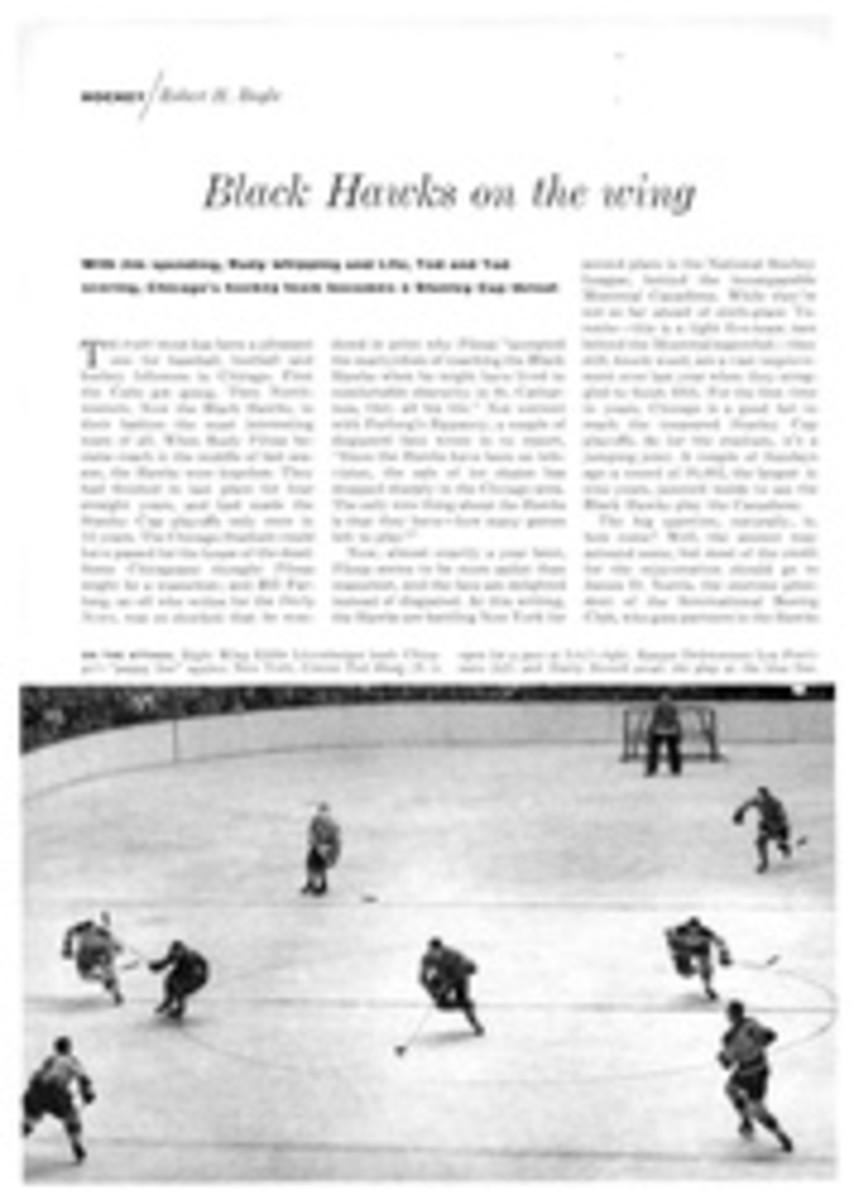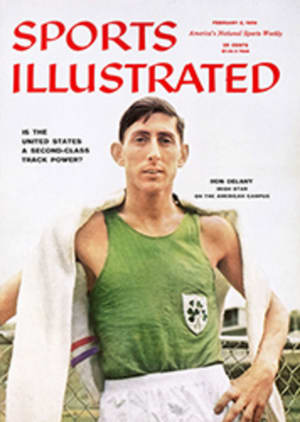
FOOTBALL'S JET-AGE SECRET
In room 1016 at the Netherland-Hilton Hotel in Cincinnati the other day a small group of very serious men finished the outline plans for a jet-age college football conference. This is the first news of it.
Room 1016 is a big room, decorated in tones of brown—brown rug, brown and cream drapes—but the big men crowded it. The room belonged to Tom Hamilton, athletic director of the University of Pittsburgh, and the men scattered about the room represented 11 of the nation's great football powers. They had met twice before during the week-long NCAA convention in Cincinnati, and this final meeting was a summing up of their discussions plus committee reports on the various problems of operating a conference that would stretch from California to New York.
In a college-football climate made uncomfortable by the ever-growing competition of professional football and the withdrawal of more major conferences into round-robin schedules which virtually exclude the independents, these major independents were seriously considering an adventure in Togetherness.
By the time they adjourned for dinner at the end of the late-afternoon session, the blueprint for the new conference was clearly drawn. None of the schools represented is committed—the actual go-ahead signals will have to come from the college presidents—but the athletic directors are now able to go to work on arguments and presentations to submit to the top executives involved. As outlined in Cincinnati, the conference will consist of 12 schools divided into eastern and western divisions. In the East will be Army, Navy, Notre Dame, Pittsburgh, Syracuse and Penn State; the western division will be Southern California, UCLA, California, Washington, the Air Force Academy and perhaps Stanford. Each team will play four games in its own division and one in the other. Due to scheduling difficulties—most major colleges are scheduled three or four years ahead—conference play cannot begin before 1964 or 1965 and will involve, at the beginning at least, only football. In other major sports the schools propose to play to divisional championships, then determine the conference champion in playoffs.
These were the major accomplishments of the meeting. Still open to discussion and arbitration are the thorny problems of recruiting, scholarships and eligibility rules.
Here are the men who were present and who will thresh out these problems soon: Tom Hamilton of Pitt, unofficial chairman of the group; Colonel Francis Roberts of West Point; Captain Slade Cutter of Annapolis; Lew Andreas of Syracuse; Moose Krause, athletic director of Notre Dame, and Father Edmond Joyce, executive vice-president of Notre Dame; Ernest B. McCoy of Penn State; Colonel George Simler of the Air Force Academy; Wilbur Johns, athletic director, and Bradford Booth, faculty athletic representative, UCLA; Jess Hill, athletic director, and Hugh Willett, faculty athletic representative, Southern Cal.; George Briggs, athletic director, and Jack Gose, faculty athletic representative, University of Washington; and Greg Engelhard, University of California. Absent but interested was Stanford Athletic Director Chuck Taylor, who told us, "We'll be most interested in reading what you fellows write about it."
The toughest problem they have to solve has to do with athletic scholarships, recruiting and academic requirements.
"Some of the California schools could not live under the restrictions of the eastern colleges," says Cutter, the outspoken representative from the Naval Academy. "Nor could we live under some of their rules. All of the colleges involved, however, have high academic requirements and it is not impossible to develop a comfortable framework for the conference as a whole."
The two eastern service academies, which have been somewhat restive under what they consider irksome and sometimes unfair restrictions imposed upon them by the Eastern Collegiate Athletic Conference, are leery of additional restrictions.
The benefits of a national conference for the independents are fairly obvious. Notre Dame's Moose Krause says, "The best reason for the creation of a new conference is that each scheduled conference game immediately assumes greater importance because it helps determine the member college's final place in the conference standings." As it now stands, a game between, say, Navy and Syracuse is important only if one of the two schools happens to be in the top 10. "I think those ratings are foolish," says Cutter. "But that's the way it is now. If we were in a conference with Syracuse, the game would be more attractive not only from a spectator's standpoint but from a publicity standpoint as well. It would give the sportswriters something additional to write about."
Not so freely admitted, but still very much present in the reasons for the new conference is the competition college football is beginning to feel from the professionals. The new collegiate conference would, in geographical distribution and in its method of scheduling, nearly duplicate the setup of the highly successful National Football League.
"Some of the independents are beginning to feel a little pinch—in the areas where professional football has become very popular," Cutter said. "I think, too, that all the recent publicity about the excellence of professional football as compared to college football is out of balance. We can't fight that by crawling into a hole and playing football which is the equivalent of high school football, as some colleges are doing. This conference, I believe, can be a real shot in the arm to college football by proving that the college game, too, is good. By forming a conference of schools with uniformly high academic standards and uniformly good football teams we can prove that academic excellence and football strength can go hand in hand."
The new conference would ease the scheduling headaches of some of the member colleges and would be no problem to the others. "As a service school, we like to play schedules which pretty well cover the United States," Colonel Roberts points out. "This conference meets that requirement. Besides, we have been playing all these schools anyway. The scheduling will not be difficult, although I should imagine it would be the mid-'60s anyway before a real conference schedule could be worked out."
Another advantage to the member schools—and an important one—was underlined by several of the athletic directors. George Briggs of Washington probably explained it best: "My own feeling is that the primary factor in favor of the idea is the opportunity such an organization would provide for combining the effectiveness of our common feelings on such matters as national intercollegiate legislation. We've gone too far already in sacrificing institutional autonomy; this could be a device for preserving and strengthening it. From the standpoint of having an organization in formation and capable, let's say, of influencing NCAA-type legislation affecting intercollegiate athletics, my hunch is that agreement by 1960 would be quite possible. To be operational in terms of scheduling is quite another matter, though."
All in all, the new conference would be an advantage to the member schools. Since it is made up of independents, it does not disrupt any conference now existing. None of the athletic directors made direct mention of one of the biggest advantages—the increased gate receipts to be expected from participation in a conference which will be the strongest in the nation, or the advantage to be expected in recruiting boys to play in that conference. It is easy to see, too, what a tremendously attractive TV package this conference would have to offer. And, if it can be worked out, a playoff between the eastern and western division would very likely outshine any current bowl game in popular appeal. These are very real reasons and very strong ones for the acceptance this idea has picked up so quickly. The fact that these reasons carry weight is no criticism of the schools involved, any more than it is a criticism of the Big Ten schools to say that similar considerations have long applied there, too: the Big Ten is a strong and attractive conference for spectators and for athletes.
The dissolution of the nine-member Pacific Coast Conference will clear the way for the creation of the proposed new airplane conference. The athletic directors of the four big West Coast schools—now suddenly independents—all considered that the achievement of a strong voice in NCAA affairs would be one of the valuable results of the new Togetherness. The same thought was, if not so dominantly, a factor with the experienced independents of the East.
Incidentally, if the new conference should use its undoubted strength to try to ease the strict but just rules of the NCAA, then it would be better for collegiate athletics if it never comes into being. No prediction is made here that anything like this will be attempted, but it is no secret that some of the proposed members—notably on the West Coast—have squirmed under the NCAA penalties.
Also, incidentally, and probably without being conscious of it, the conferees in Room 1016 in the Netherland-Hilton were outlining a college football program for the 1960s in direct challenge to the thesis of that tireless old opponent of college football, Chicago's Robert M. Hutchins, whose advice to other college presidents has long been: "Give it up and let the pros have it."
In his sternest manner, Hutchins has written (see below) that college football can never be as good, as entertaining and solvent as the professional game. The athletic directors of a dozen or so of the nation's finest colleges are out to prove Hutchins and his disciples wrong. And they just might do it.
ILLUSTRATION
MARC SIMONT
CONFEREES IN POSSIBLY HISTORIC CINCINNATI HOTEL ROOM INCLUDED MEN FROM USC, UCLA, AIR FORCE ACADEMY, WASHINGTON, CALIFORNIA, PITTSBURGH, NAVY, ARMY, NOTRE DAME, PENN STATE, SYRACUSE, WHILE STANFORD WATCHED FROM A DISTANCE
PHOTO
WILBUR JOHNS
UCLA
PHOTO
JESS HILL
Southern California
PHOTO
GREG ENGELHARD
California
PHOTO
GEORGE BRIGGS
Washington
PHOTO
LEW ANDREAS
Syracuse
PHOTO
FRANCIS ROBERTS
Army
PHOTO
SLADE CUTTER
Navy
PHOTO
CHUCK TAYLOR
Stanford
PHOTO
GEORGE SIMLER
Air Force Academy
PHOTO
MOOSE KRAUSE
Notre Dame
PHOTO
TOM HAMILTON
Pittsburgh
PHOTO
ERNEST McCOY
Penn State
PHOTO
HE'D GIVE THE GAME TO THE PROS
HUTCHINS' DOCTRINE FOR FOOTBALL
Plans of the nation's major college football independents to form a jet-age conference of their own—fit to challenge the increasingly popular pros for the public's support and attention—also bravely challenge the advice of that longtime critic of college football, former President Robert Hutchins of the University of Chicago. Excerpts from the Hutchins doctrine and prophecy, as written for SPORTS ILLUSTRATED more than four years ago (SI, Oct. 18, '54):
"The real hope lies in the slow but steady progress of professional football.... Not enough people will pay enough money to support big-time intercollegiate football in the style to which it has become accustomed when for the same price they can see real professionals, their minds unconfused by thoughts of education, play the game with true professional polish.
"When professional football has reached this point, we shall be able to disentangle sport and higher education. Students can play (or not play) as they wish: their friends may attend and applaud if they like....
"Students will come to college to study. Alumni will believe that this is something a normal, red-blooded young American can properly do.... This happened at Chicago."

